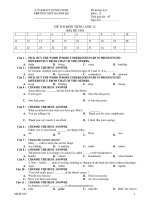- Trang chủ >>
- Đề thi >>
- Đề thi lớp 12
Đề thi môn tiếng anh 12 phần đọc hiểu số 9
Bạn đang xem bản rút gọn của tài liệu. Xem và tải ngay bản đầy đủ của tài liệu tại đây (53.54 KB, 1 trang )
Đề thi môn tiếng anh 12 phần đọc hiểu số 9:
Species that belong to an area are said to be native species. Typically, they have been part of a given
biological landscape for a long period, and they are well adapted to the local environment and to the
presence of other native species in the same general habitat. Exotic species are interlopers, foreign
elements introduced intentionally or accidentally into new settings through human activities. In one
context an introduced species may cause no obvious problems and may, over time, be regarded as
being just as "natural" as any native species in the same habitat. In another context, exotics may
seriously disrupt delicate ecological balances and create a cascade of unintended consequences. The
worst of these unintended consequences arise when introduced species put native species in destruction
by preying on them, altering their habitats, or out-competing them in the struggle for food resources.
Although biological introductions have affected environments the world over, the most destructive,
effects have occurred on islands, where introduced insects, cats, pigs, rats, mongooses, and other
nonnative species have caused the grave endangerment or outright extinction of literally hundreds of
species during the past 500 years.
One of other reason to cause species extinction is overexploitation. This word refers to the utilization of
a species at a rate that is likely to cause its extreme endangerment or outright extinction. Among many
đề thi môn anh 12 phần đọc hiểu số s of severe overexploitation, the case of the great whales stands out
in special relief. By the middle of the 20th century, unrestricted whaling had brought many species of
whales to incredibly low population sizes. In response to public pressure, in 1982 a number of nations,
including the USA, agreed to an international moratorium on whaling. As a direct result, some whale
species which are thought to have been on extinction′s doorstep 25 years ago have made amazing
comebacks, such as grey whales in the western Pacific. Others remain at great risk. Many other species,
however, continue to suffer high rates of exploitation because of the trade in animal parts. Currently,
the demand for animal parts is centered in several parts of Asia where there. is a strong market for
traditional medicines made from items like tiger bone and rhino horn.
31. Native species _______.
a. are not used to the local environment
b. never get along well with other native species in the same environment
c. tend to do harm to exotic species
d. have been part of a given biological landscape for a long period
32. Exotic species _______.
a. do no harm to native species and the local environment
b. may kill native species for food
c. always share the environment peacefully with native species
d. help to make the local environment more ideal to survive
33. According to the first paragraph, _______.
a. non-native species have caused badly damage to native ones
b. introducing new exotic species to local environments is necessary
c. exotic species have never been introduced on islands
d. very few native species have been damaged by exotic species
34. According to the second paragraph, by the middle of the 20 century ___.
a. whale population was the most crowded in marine life
b. whale hunting was illegal
c. whale population increased dramatically
d. whaling was not restricted
35. Tiger bone and rhino horn _______.
a. are not popular in Asian markets
b. are never in the trade of animal parts
c. are used for making traditional medicines
d. cannot be found in Asian markets








